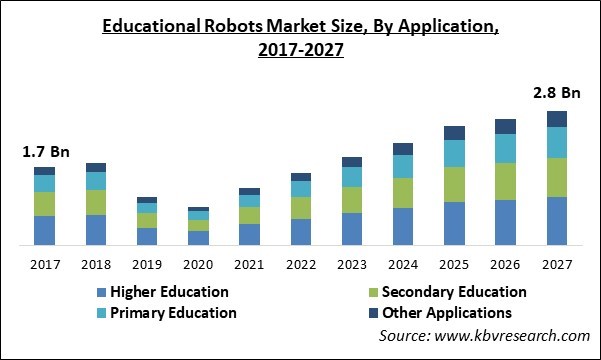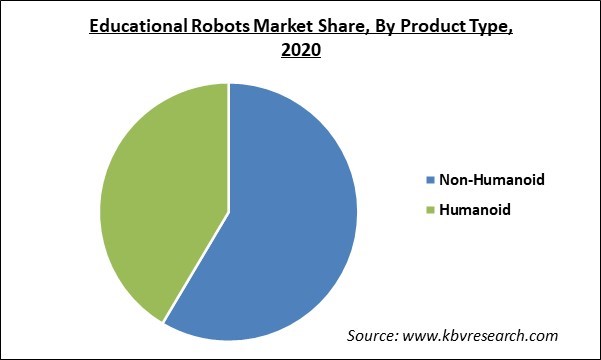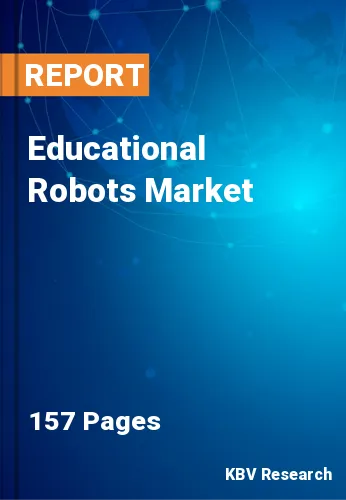The Global Educational Robots Market size is expected to reach $2,872.8 million by 2027, rising at a market growth of 15.4% CAGR during the forecast period.
Educational robotics is a concept of teaching the application, analysis, and operation through a variety of robots such as mobile robots, articulated robots, or autonomous vehicles. These robots can help a person in their learning process from school to graduation.
With advanced computing ability and innovative engineering, educational robots can be controlled through voice, gestures, and other special apps. In addition, they can improve creative problem-solving techniques, as well, as boost the growth of necessary communication & interpersonal skills and the power to transmit and integrate complicated innovations to their mates.

The educational infrastructure was crucially affected during the period of pandemic and has not recovered till yet. All education institutions were shut. The COVID-19 pandemic bought a few modifications into the education sector. The education industry suffered a massive breakdown as all the institutes including schools, universities, and coaching centers were closed for a significant duration. The hazardous coronavirus also affected the supply chain of educational robot producers and also hindered the market. The imposition of complete lockdown by the governments has disrupted imports and exports of any products that resulted in a significant drop in the demand for educational robots. Moreover, a huge cost of investment in the initial stage hinders the development of the market.
The emerging trend and adoption of digitization as well as the addition of machine learning, artificial intelligence, and other advanced technologies into the day-to-day life of people as well as in the educational infrastructure is one of the major catalysts in the growth of educational robots market. Educational robots are rapidly being demanded in elementary schools, high schools, colleges, and other educational institutes with the purpose of facilitating the process of teaching as well as making the learning process less complicated and interesting for the students.
The humanoid robot has the capacity to evolve the educational robots market. There are numerous researches going on about how to transmit programming of a robot into other humanoid robot, wherein researchers are developing ingenious software solutions as software is considered as a vital part of humanoid robots. For example, MIT’s Computer Science and Artificial Intelligence Laboratory designed a technique of machine learning named C-learn which enables non-coders to train robot movements and assessments giving fundamental information on the objects that are being directed.
The cost of establishing a robots-based education center might not be affordable for every school, college, and other educational institutes, especially for the newcomers to the sector. The expenditure required to purchase educational robots and integrate the robot along with its maintenance would be very high. The institutions that require additional infrastructure or do not have any tie-ups with robot manufacturers would not be able to bear the cost of educational robots. These hindrances would majorly occur in the under-developed or developing countries with low purchasing or spending capacity or do not have significant existence of robot manufacturers.

Based on Application, the market is segmented into Higher Education, Secondary Education, Primary Education, and Others Applications. The primary education segment procured a prominent revenue share in the educational robots market in 2020 and is expected to showcase the fastest growth rate during the forecast period.
Based on Product type, the market is segmented into Non-Humanoid and Humanoid. The Humanoid segment is expected to display the fastest growth rate during the forecast period. The increasing demand for humanoid robots is attributed to their next-generation features and expanding range of applications throughout numerous sectors of the educational infrastructure can attribute to the rise in its growth.
| Report Attribute | Details |
|---|---|
| Market size value in 2020 | USD 817.6 Million |
| Market size forecast in 2027 | USD 2,872.8 million |
| Base Year | 2020 |
| Historical Period | 2017 to 2019 |
| Forecast Period | 2021 to 2027 |
| Revenue Growth Rate | CAGR of 15.4% from 2021 to 2027 |
| Number of Pages | 157 |
| Number of Tables | 262 |
| Report coverage | Market Trends, Revenue Estimation and Forecast, Segmentation Analysis, Regional and Country Breakdown, Companies Strategic Developments, Company Profiling |
| Segments covered | Application, Product Type, Region |
| Country scope | US, Canada, Mexico, Germany, UK, France, Russia, Spain, Italy, China, Japan, India, South Korea, Singapore, Malaysia, Brazil, Argentina, UAE, Saudi Arabia, South Africa, Nigeria |
| Growth Drivers |
|
| Restraints |
|
Based on Regions, the market is segmented into North America, Europe, Asia Pacific, and Latin America, Middle East & Africa. North America emerged as the leading region in the educational robots market in 2020 and is expected to hold its position during the forecast period. The existence of the key market players and the high adoption rate of the next-generation technologies across the educational infrastructure as a result of increasing awareness of activity-based education evolution in educational guidelines are the major drivers of the growth of the regional educational robots market.
Free Valuable Insights: Global Educational Robots Market size to reach USD 2,872.8 million by 2027
The market research report covers the analysis of key stake holders of the market. Key companies profiled in the report include ABB Group, FANUC Corporation, Yaskawa Electric Corporation, SoftBank Group Corporation (SoftBank Robotics), Teradyne, Inc. (Universal Robots), Techman Robot, Inc. (Quanta Storage, Inc.), Seiko Epson Corporation, Hanson Robotics Limited, SZ DJI Technology Co., Ltd. (iFlight Technology Company Limited), and Kuka AG.
By Application
By Product Type
By Geography
The educational robots market size is projected to reach USD 2,872.8 million by 2027.
Growing trend of digitization are driving the market in coming years, however, high cost of educational robots limited the growth of the market.
ABB Group, FANUC Corporation, Yaskawa Electric Corporation, SoftBank Group Corporation (SoftBank Robotics), Teradyne, Inc. (Universal Robots), Techman Robot, Inc. (Quanta Storage, Inc.), Seiko Epson Corporation, Hanson Robotics Limited, SZ DJI Technology Co., Ltd. (iFlight Technology Company Limited), and Kuka AG.
The expected CAGR of the educational robots market is 15.4% from 2021 to 2027.
The Higher Education market dominated the Global Educational Robots Market by Application in 2020 thereby growing at a CAGR of 14.9% during the forecast period.
The North America market dominated the Global Educational Robots Market by Region in 2020, and would continue to be a dominant market till 2027; thereby, achieving a market value of $970.2 Million by 2027.
Our team of dedicated experts can provide you with attractive expansion opportunities for your business.

